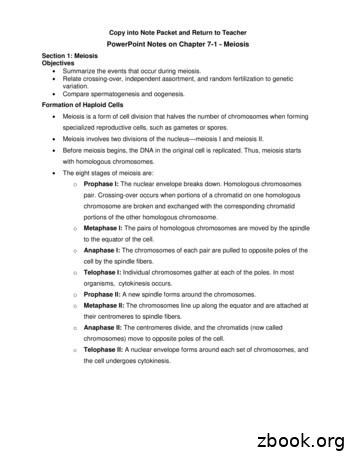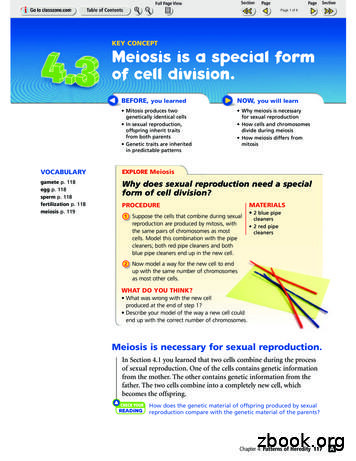Meiosis And Human Life Cycle - Minia
Meiosis and human life cycleCopyright The McGraw-Hill Companies, Inc. Permission required for reproduction or display.5-1
Cell Increase and DecreaseCell division increases the number ofsomatic (body) cells, and consists of: Mitosis (division of nucleus) Cytokinesis (division of cytoplasm)Apoptosis (cell death) decreases thenumber of cells.Both cell increase and apoptosis occurduring normal development andgrowth.5-2
Maintaining the ChromosomeNumberWhen a eukaryotic cell is not dividing,the DNA and associated proteins is atangled mass of thin threads calledchromatin.At the time of cell division, the chromatincondenses to form highly compactedstructures called chromosomes.Each species has a characteristicnumber of chromosomes.5-3
Overview of MitosisThe diploid number of chromosomes isfound in the somatic (non-sex) cells.The diploid (2n) number of chromosomescontains two chromosomes of eachkind.The haploid (n) number of chromosomescontains one chromosome of eachkind.5-4
In the life cycle of many animals, onlysperm and eggs have the haploidnumber of chromosomes.The nuclei of somatic cells undergomitosis, a nuclear division in which thenumber of chromosomes staysconstant.Before nuclear division occurs, DNAreplication takes place, duplicating thechromosomes.5-5
A duplicated chromosome is made of twosister chromatids held together in aregion called the centromere.Sister chromatids are geneticallyidentical.At the end of mitosis, each chromosomeconsists of a single chromatid.During mitosis, the centromeres divideand then the sister chromatidsseparate, becoming daughterchromosomes.5-6
5-7
Following mitosis, a 2n parental cellgives rise to two 2n daughter cells, or2n 2n.The cells of some organisms (algae,fungi) are haploid as adults; n n.Mitosis occurs when tissues grow orwhen repair occurs.Following fertilization, the zygote dividesmitotically, and mitosis continuesthroughout the lifespan of theorganism.5-8
How Plant Cells DividePlant cells lack centrioles and asters, buthave a centrosome and spindle and thesame four stages of mitosis.Meristematic tissue, in shoot and roottips, retains the ability to dividethroughout life.Lateral meristems accounts for the abilityof trees to grow in girth.5-9
Reducing the ChromosomeNumberMeiosis reduces the chromosomenumber such that each daughter cellhas only one of each kind ofchromosome.The process of meiosis ensures that thenext generation will have:1) the diploid number of chromosomes2) a combination of traits that differsfrom that of either parent.5-10
Overview of meiosis5-11
Overview of MeiosisMeiosis requires two nuclear divisionsand four haploid nuclei result.Humans have 23 pairs of homologouschromosomes, or 46 chromosomestotal.Prior to meiosis I, DNA replicationoccurs.During meiosis I, synapsis occurs.5-12
Meiosis I separates homologouspairs of chromosomes.Daughter cells are haploid, butchromosomes are still induplicated condition.No replication of DNA occursbetween the two divisions.5-13
Meiosis II separates sisterchromatids.In many life cycles, haploid daughtercells mature into gametes.Fertilization restores the diploidnumber of chromosomes duringsexual reproduction.5-14
Genetic RecombinationThere are two sources of geneticrecombination during meiosis:1) crossing-over of nonsister chromatidsand2) independent assortment ofhomologous chromosomes.Both events assure new geneticcombinations in the offspring.5-15
Synapsis and crossing-over5-16
Independent assortment5-17
Meiosis in DetailThe same four phases seen in mitosis –prophase, metaphase, anaphase, andtelophase – occur during both meiosis Iand meiosis II.The period of time between meiosis I andmeiosis II is called interkinesis.No replication of DNA occurs duringinterkinesis because the DNA is alreadyduplicated.5-18
Meiosis I in an animal cell5-19
5-20
Meiosis II5-21
5-22
Sources of Genetic VariationAs a result of meiosis followed byfertilization, there are three sources ofgenetic recombination:1) Independent alignment of pairedchromosomes along the metaphase Iplate2) Crossing-over during prophase I3) Combining of chromosomes ofgenetically different gametes5-23
Comparison of Meiosis withMitosisIn both mitosis and meiosis, DNAreplication occurs only once duringinterphase.Mitosis requires one division whilemeiosis requires two divisions.Two diploid daughter cells result frommitosis; four haploid daughter cellsresult from meiosis.5-24
Daughter cells from mitosis aregenetically identical to parental cells;daughter cells from meiosis are notgenetically identical to parental cells.Mitosis occurs in all somatic cells forgrowth and repair; meiosis occurs onlyin the reproductive organs for theproduction of gametes.5-25
Comparison of Meiosis I toMitosisMeiosis I:Prophase I - pairing ofhomologouschromosomesMetaphase I –homologous pairs line upat metaphase plateAnaphase I – homologouschromosomes separateTelophase I – daughtercells are haploidMitosis:Prophase has no suchpairingMetaphase –chromosomes align atmetaphase plateAnaphase – sisterchromatids separateTelophase – diploid cells5-26
Comparison of Meiosis II toMitosisThe events of meiosis II are like those ofmitosis except in meiosis II, the nucleicontain the haploid number ofchromosomes.At the end of telophase II of meiosis II,there are four haploid daughter cellsthat are not genetically identical.At the end of mitosis, there are twodiploid daughter cells that are identical.5-27
Meiosis compared to mitosis5-28
The Human Life CycleThe human life cycle requires bothmitosis and meiosis.In males, meiosis occurs asspermatogenesis and produces sperm.In females, meiosis occurs as oogenesisand produces egg cells.Mitosis is involved in the growth of achild and repair of tissues during life.5-29
Spermatogenesis in human malesproduces four viable haploid sperm.Diploid primary spermatocytes undergomeiosis I to produce haploid secondaryspermatocytes.Secondary spermatocytes divide bymeiosis II to produce haploidspermatids.Spermatids mature into sperm with 23chromosomes.5-30
Spermatogenesis5-31
During oogenesis, a diploid primaryoocyte undergoes meiosis I to produceone haploid secondary oocyte and onehaploid polar body.The secondary oocyte begins meiosis IIbut stops at metaphase II and isreleased at this stage from the ovary.Meiosis II will be completed only if spermare present.Following meiosis II, there is one haploidegg cell with 23 chromosomes and upto three polar bodies.Polar bodies serve as a dumping groundfor extra chromosomes.5-32
Oogenesis5-33
In humans, both sperm cells and the eggcell have 23 chromosomes each.Following fertilization of the egg cell by asingle sperm, the zygote has 46chromosomes, the diploid numberfound in human somatic cells.The 46 chromosomes represent 23 pairsof homologous chromosomes.5-34
Genetic Recombination inHumansThere are three ways in which meiosisand fertilization ensure that a childhas a different combination of genesfrom that of either parent:1) Independent assortment ofchromosomes during metaphase I2) Crossing-over during prophase I3) Upon fertilization, recombination ofchromosomes occurs.5-35
Chapter SummaryCell division increases the number ofbody cells; apoptosis decreases it.Cells goes through a cell cycle that hasthree control checkpoints.Each species has a characteristicnumber of chromosomes.Mitosis has four phases and maintainsthe chromosome number.5-36
Mitosis is used for growth and repair.Meiosis reduces the chromosomenumber and includes two nucleardivisions.The human life cycle includes bothmitosis and meiosis.Meiosis and fertilization in humans andother sexually reproducing organismsresult in genetic recombination in theoffspring.5-37
Comparison of Meiosis II to Mitosis The events of meiosis II are like those of mitosis except in meiosis II, the nuclei contain the haploid number of chromosomes. At the end of telophase II of meiosis II, there are four haploid daughter cells that are not genetically identical. At the end of mitosis, there are two
Cell Division in Sexual Reproduction: Meiosis Meiosis is the mechanism by which eukaryotic cells produce mature sex cells or gametes Meiosis produces four haploid cells (gametes) Meiosis involves partition of both cytoplasmic and nuclear structures Meiosis consists of Meiosis I and Meiosis II. Both phases are followed by .
TAKING NOTES Draw a Venn diagram like the one below to summarize the similarities and differences between meiosis I and meiosis II. chromo-somes condense divides homologous chromosomes divides sister chromatids Meiosis I Meiosis II 6.2 Process of Meiosis KEY CONCEPT During meiosis, diploid ce
Meiosis is a form of cell division that halves the number of chromosomes when forming specialized reproductive cells, such as gametes or spores. Meiosis involves two divisions of the nucleus—meiosis I and meiosis II. Before meiosis begins, the DNA in the original cell is replicated. Thus, meiosis starts with homologous chromosomes.
During meiosis, a single cell goes through two cell divisions—meiosis I and meiosis II. Meiosis takes place only in the reproductive tissues of an organism. Cells divide twice during meiosis. Before meiosis begins, the chromosomes of the parent cell are copied. A cell that is ready to divide contains two copies of each
I II III IV A DNA Replication Mitosis Meiosis Fertilisation B DNA Replication Meiosis 1 Meiosis 2 Fertilisation C Fertilisation Meiosis Mitosis DNA Replication D Mitosis Meiosis 1 Meiosis 2 DNA Replication 4.4 In analysing the number of different bases in a DNA sample, the following result would be consistent with the base-pairing rules: .
II. Process of Meiosis (6.2) A. Cells go through _ rounds of division in meiosis 1. Meiosis produces _ haploid cells from one diploid cell 2. Process involves two rounds of _ _- Meiosis I and Meiosis II. B. Homologous Chromosomes and sister Chromatids 1.
Now that you've seen how meiosis works, let's review two key differ-ences between the processes of meiosis and mitosis. Meiosis has two cell divisions. Mitosis has only one cell division. Meiosis results in haploid cells. Mitosis results in diploid cells. On the diagram above, circle the part in the process of meiosis
Meiosis is a process in which the number of chromosomes per cell is cut in half through the separation of homologous chromosomes in a diploid cell. Meiosis usually involves two distinct divisions, called meiosis I and meiosis II. By the end of meiosis II, the diploid cell becomes four haploid cells.File Size: 796KB























